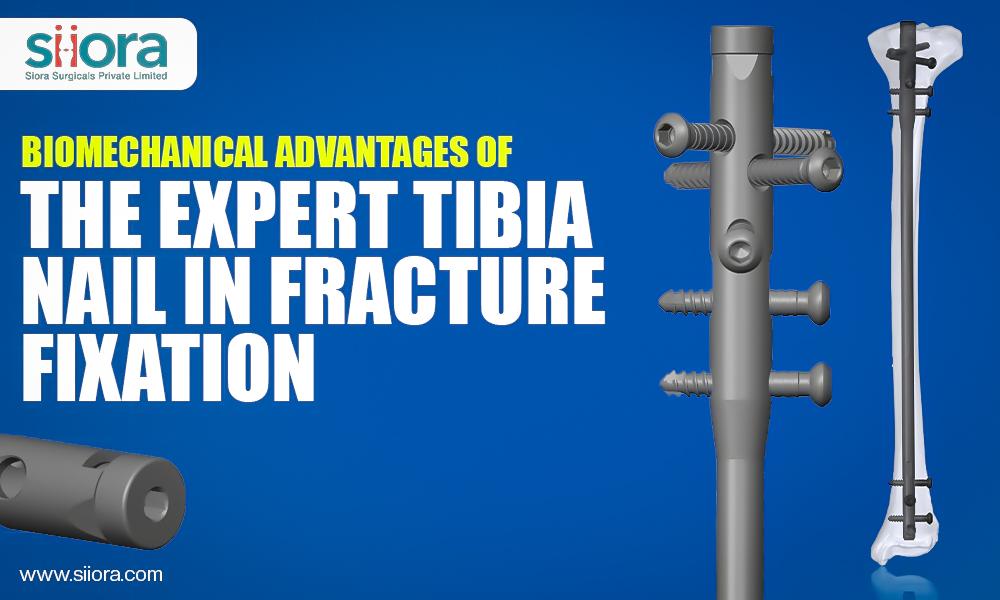Fractures of the tibia are among the most common long-bone injuries encountered in orthopedic practice. Because of the tibia’s subcutaneous location and limited soft tissue coverage, these injuries are frequently associated with complications such as poor healing, infection, and malalignment. Over the years, intramedullary (IM) nailing has become the gold standard for many tibial fractures because it allows for stable fixation, early mobilization, and reduced soft tissue compromise compared to traditional plating methods. Among the newer generations of IM nails, the Expert Tibia Nail (ETN) has been specifically engineered to address biomechanical and clinical challenges that conventional nails were unable to fully overcome.
Improved Anatomical Fit and Versatility
One of the key biomechanical strengths of the Expert Nail lies in its design. Unlike earlier nails that often struggled to match the natural curvature of the tibia, the ETN incorporates a more anatomical bend. This adaptation reduces stress concentration at the nail–bone interface and promotes a more even load transfer along the fracture site. By aligning more naturally with the tibial canal, the ETN minimizes the risk of malalignment, especially in distal and proximal fractures where maintaining correct rotational and angular alignment is particularly difficult.
Additionally, the ETN is versatile enough to treat a wide spectrum of fractures, ranging from simple transverse fractures to complex multi-fragmentary injuries. This adaptability ensures that surgeons can employ the same fixation system across varied clinical scenarios, leading to more predictable biomechanical stability and fewer compromises in surgical technique.
Superior Locking Options
Traditional nails often had limited locking screw configurations, which made control of rotational stability challenging. The Expert Tibia Nail advances this area significantly through multiple multidirectional locking options. Its distal locking holes are strategically oriented to provide enhanced stability in both the sagittal and coronal planes. This feature is especially valuable in managing fractures close to the metaphysis, where maintaining fixation is notoriously difficult.
Biomechanically, these locking options reduce the risk of micromotion at the fracture site, thereby supporting secondary bone healing through callus formation. They also allow surgeons to adopt a “multiplanar fixation strategy,” distributing stress more evenly across the construct and reducing the likelihood of screw breakage or nail migration.
Load Sharing and Stress Distribution
An important principle in fracture fixation is the balance between stability and the allowance for microstrain that stimulates healing. The ETN is designed as a load-sharing implant rather than a load-bearing one. This means that physiological stresses are transferred across the bone rather than being absorbed solely by the implant, thereby encouraging natural bone consolidation.
Furthermore, the central intramedullary positioning of the nail places it closer to the mechanical axis of the tibia. From a biomechanical perspective, this reduces the bending moment acting on the implant compared to plates, which are positioned eccentrically on the bone surface. This central axis alignment not only prolongs implant longevity but also decreases the risk of fatigue failure.
Enhanced Stability in Osteoporotic and Complex Fractures
Fracture fixation in osteoporotic bone poses significant challenges due to compromised screw purchase. The Expert Tibia Nail offers an advantage through its angular stable locking options, which provide a fixed-angle construct. This results in improved screw anchorage and reduces the risk of screwdriver loosening, even in weaker bones. Beyond osteoporotic cases, the system’s stability makes it a reliable option for segmental and comminuted fractures, where fixation demands are more complex.
Facilitation of Early Mobilization
One of the most practical clinical implications of the ETN’s biomechanical efficiency is early patient rehabilitation. By providing reliable stiffness without completely shielding the bone from stress, the implant allows partial weight-bearing soon after surgery. This advantage reduces the risks associated with prolonged immobilization, such as joint stiffness, muscle wasting, and deep vein thrombosis. Early mobilization, supported by the biomechanical stability of the ETN, translates to faster functional recovery and improved patient outcomes.
Conclusion
The Expert Tibia Nail represents a significant step forward in the biomechanical management of tibial fractures. Its anatomical fit, versatile locking options, and ability to provide stable yet biologically favorable fixation make it superior to earlier designs. By combining reliable load-sharing mechanics with innovative angular stability, the ETN addresses the critical challenges of tibial fracture fixation, ranging from malalignment to poor healing in osteoporotic bone. For both surgeons and patients, this translates into more predictable outcomes, faster rehabilitation, and reduced complication rates.
If you are looking to get a world-class range of trauma implants, including expert tibia nails, contact Siora Surgicals Pvt. Ltd., a top orthopaedic company in India, with a huge global presence.

